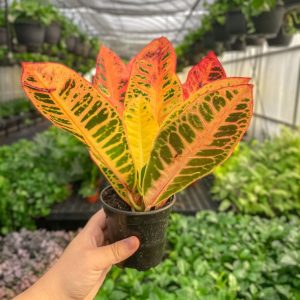Variety Pack Croton

- Botanical Name: Codiaeum variegatum (L.) A. Juss.
- Family Name: Euphorbiaceae
- Stems: 2-6 Feet
- Temperature: 13°C-30°C
- Others: Warm, humid conditiona, abundant sunlight, not cold-resistant
Overview
Product Description
Codiaeum variegatum: A Tropical Tour de Force for Indoors and Out
Codiaeum variegatum: The Tropical Spectrum in Your Home
Origin of Variety Pack Croton
Variety Pack Croton, scientifically known as Codiaeum variegatum, originates from Southeast Asia, particularly in countries like Malaysia, Indonesia, and the Philippines. This plant is a popular ornamental species known for its vibrant and colorful foliage.

Variety Pack Croton
Habits of Variety Pack Croton
Croton plants thrive in warm temperatures and require a fair amount of humidity to maintain the health and vibrancy of their leaves. They prefer bright, indirect light to prevent scorching, which can lead to leaf burn. Crotons are not frost-tolerant and are typically grown as houseplants in temperate climates. They have a tropical growth habit and are sensitive to cold drafts and sudden changes in temperature. The plants are also relatively drought-tolerant once established but prefer evenly moist soil conditions.
The Spectrum of Splendor: Understanding Croton’s Colorful Canvas
Leaf Architecture of Variety Pack Croton
Variety Pack Croton, scientifically known as Codiaeum variegatum, is renowned for its striking foliage that exhibits a spectrum of colors. The leaves are typically large, with serrated or lobed edges, and they can display a range of hues from vibrant reds, oranges, yellows, to greens, often with multiple colors present on a single leaf. The leaves are usually glossy and possess a waxy texture, which enhances their visual appeal.
Influence of Light on Color Intensity
Light is a critical factor in the development of the Croton’s leaf colors. Full sun exposure can deepen the colors, particularly the reds and yellows, while partial shade may result in a more subdued, greener palette. The intensity and quality of light directly influence the vibrancy of the colors, making it essential to provide the appropriate lighting conditions for the desired color expression.
Environmental and Nutritional Factors on Color Variation
Temperature fluctuations, proper watering, and balanced fertilization also play significant roles in maintaining the health and color of Croton leaves. Over-watering or under-watering can lead to discoloration or leaf drop. Additionally, the pH level of the soil impacts nutrient uptake, which in turn affects leaf color. Crotons prefer a slightly acidic to neutral pH, which helps achieve the best color expression. Lastly, the specific variety of Croton and its genetic makeup contribute to the color pattern and intensity, with some varieties bred for more vibrant colors or unique combinations.
Croton Camouflage: Where the Party Colors Grow
Home Interiors
Variety Pack Croton, with its vibrant and multicolored foliage, is an excellent choice for enhancing the aesthetics of home interiors. Its ability to bring a touch of the tropics indoors makes it a popular addition to living rooms, where it can serve as a focal point near windows or in corner spaces. The plant’s colorful leaves also complement modern and eclectic decor styles, providing a lively contrast to more neutral color schemes.
Office and Commercial Spaces
Crotons are also suitable for office and commercial settings, where their striking appearance can enliven workspaces and common areas. In offices, they can be used to create a more inviting and dynamic environment, potentially boosting employee morale and creativity. Their adaptability to various light conditions makes them a practical choice for spaces with limited natural light, such as interior offices or conference rooms.
Outdoor Landscapes
In tropical and subtropical climates, Crotons can be incorporated into outdoor landscapes, where they can serve as a colorful accent in gardens and courtyards. They are particularly effective when used in mixed plantings or as a hedge, providing a burst of color and texture. Their tropical appearance also makes them a natural fit for tiki bars, restaurants with a Polynesian theme, or any setting that seeks to evoke a lush, exotic atmosphere.










